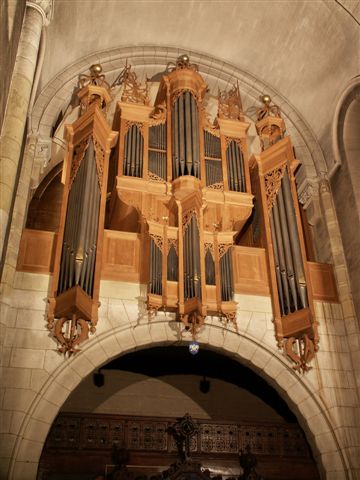|
The Aubertin Organ of St Louis’s Church in Vichy was inaugurated on 5-6 January 1991.
The organ occupies the prime position in the church for any organ: in the west gallery, where it has the greatest acoustical advantage as well as the best visual effect. Its layout is both coherent and aesthetically appealing, and follows traditional patterns: the Grand Orgue (Great), with the “mirrored” arrangement of its front pipes, is in a commanding position above the Positif, slung from the parapet, with the two pedal towers, similarly low-slung, on either side. The top of the main case houses the Récit, close up against the vault.
 Andre Piroche photo, Vichy, 1991.
Andre Piroche photo, Vichy, 1991.
The façade of the organ-case is harmoniously proportioned and is adorned with ornamental carvings which allude to the place and its history: salmon of the River Allier, on which Vichy stands, Napoleonic eagles, and plant motifs.
Materials used are of the highest quality: oak for the casework, frame and chests; pewter and lead-alloys or spruce-wood for the pipes; boxwood and ebony for the keys; and fruit-wood for the stop-knobs. The very light and responsive key-action allows for extremely subtle playing. The wind is distributed from three cuneiform bellows at pressures of 95mm (for the manuals) and 115mm (for the pedal stops).
 Roland Lopes photo.
Stop-knobs: Michel JEUNIER, turner.
Roland Lopes photo.
Stop-knobs: Michel JEUNIER, turner.

Click to enlarge.
Jean Convert photo, Sept 16, 2001.
The ear can distinguish the different divisions of the organ one from another, just as the eye can: the Great by its solidity and tonal grandeur, the Positif by its lighter brilliance, the Récit by its more subtle presence, and the well-structured Pedal, which is deep and broad in tone.
The written specification of an instrument can give no more than a faint suggestion of its character; the style of this particular organ is “relatively unclassifiable, though in the manner of Mitteleuropa instruments”, as Bernard Aubertin described it. Unmistakably, it bears the stamp of its builder’s personality.

It is necessary to hear for yourself the three ranks (voiced “progressively”) of the G.O. Principal, the magnificence of the reeds and mixtures, the sweetness of the flutes, and—a particular rarity—the Sixtelette on the Récit (with its unusual alternation of fourths and sixths). In fact, every one of the 47 stops is colourful and would need long description. The multiple combinations and blendings possible with this instrument will offer the sensitive musician a remarkable range of tonal possibilities: a wonderful richness of musical sound. This is why the music of Buxtehude and J. S. Bach, and also that of Sweelinck, Cabezon and Bruna can be just as well rendered here as that of Mendelssohn and Brahms—and even some contemporary compositions, if their key is compatible with the tuning of the instrument (Kirnberger III).
Françoise Pouradier Duteil
Alec Dingwall
Editor of the (British) Journal
of The Organ Club
 Roland Lopes photo, 2001.
Roland Lopes photo, 2001.
 Roland Lopes photo, 2001.
Roland Lopes photo, 2001.
|







